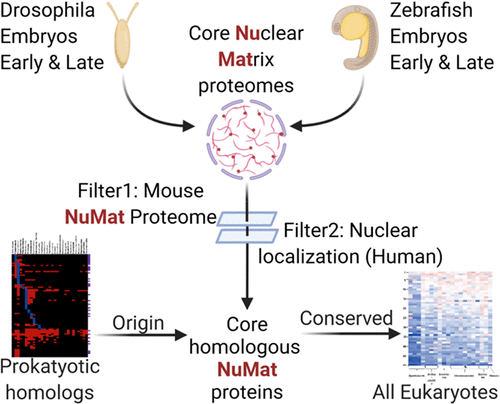当前位置:
X-MOL 学术
›
J. Proteome Res.
›
论文详情
Our official English website, www.x-mol.net, welcomes your
feedback! (Note: you will need to create a separate account there.)
Identification of Evolutionarily Conserved Nuclear Matrix Proteins and Their Prokaryotic Origins
Journal of Proteome Research ( IF 3.8 ) Pub Date : 2020-12-08 , DOI: 10.1021/acs.jproteome.0c00550 Rahul Sureka 1 , Rakesh Mishra 1
Journal of Proteome Research ( IF 3.8 ) Pub Date : 2020-12-08 , DOI: 10.1021/acs.jproteome.0c00550 Rahul Sureka 1 , Rakesh Mishra 1
Affiliation

|
Compared to prokaryotic cells, a typical eukaryotic cell is much more complex along with its endomembrane system and membrane-bound organelles. Although the endosymbiosis theories convincingly explain the evolution of membrane-bound organelles such as mitochondria and chloroplasts, very little is understood about the evolutionary origins of the nucleus, the defining feature of eukaryotes. Most studies on nuclear evolution have not been able to take into consideration the underlying structural framework of the nucleus, attributed to the nuclear matrix (NuMat), a ribonucleoproteinaceous structure. This can largely be attributed to the lack of annotation of its core components. Since NuMat has been shown to provide a structural platform for facilitating a variety of nuclear functions such as replication, transcription, and splicing, it is important to identify its protein components to better understand these processes. In this study, we address this issue using the developing embryos of Drosophila melanogaster and Danio rerio and identify 362 core NuMat proteins that are conserved between the two organisms. We further compare our results with publicly available Mus musculus NuMat dataset and Homo sapiens cellular localization dataset to define the core homologous NuMat proteins consisting of 252 proteins. We find that of them, 86 protein groups have originated from pre-existing proteins in prokaryotes. While 36 were conserved across all eukaryotic supergroups, 14 new proteins evolved before the evolution of the last eukaryotic common ancestor and together, these 50 proteins out of the 252 core conserved NuMat proteins are conserved across all eukaryotes, indicating their indispensable nature for nuclear function for over 1.5 billion years of eukaryotic history. Our analysis paves the way to understand the evolution of the complex internal nuclear architecture and its functions.
中文翻译:

进化保守核基质蛋白及其原核起源的鉴定。
与原核细胞相比,典型的真核细胞及其内膜系统和膜结合细胞器要复杂得多。尽管内共生理论令人信服地解释了诸如线粒体和叶绿体之类的膜结合细胞器的进化,但对核的进化起源(真核生物的定义特征)了解得很少。大多数关于核进化的研究都没有考虑到归因于核基质(NuMat),核糖核蛋白结构的核的潜在结构框架。这在很大程度上可以归因于其核心组件的注释不足。由于已证明NuMat提供了促进各种核功能(例如复制,转录和剪接)的结构平台,重要的是确定其蛋白质成分以更好地理解这些过程。在这项研究中,我们使用发育中的胚胎来解决这个问题。果蝇(Drosophila melanogaster)和里约热内卢(Danio rerio)鉴定了这两种生物之间保守的362种核心NuMat蛋白。我们进一步将我们的结果与可公开获得的小家鼠NuMat数据集和智人进行比较细胞定位数据集,以定义由252种蛋白质组成的核心同源NuMat蛋白。我们发现其中的86个蛋白质组源自原核生物中预先存在的蛋白质。虽然在所有真核超组中保守了36个,但在最后一个真核祖先进化之前又进化了14个新蛋白质,并且在一起的252个核心保守NuMat蛋白中的这50个蛋白质在所有真核生物中都是保守的,这表明它们对于核功能的必不可少的性质超过15亿年的真核历史。我们的分析为理解复杂的内部核结构及其功能的发展铺平了道路。
更新日期:2021-01-01
中文翻译:

进化保守核基质蛋白及其原核起源的鉴定。
与原核细胞相比,典型的真核细胞及其内膜系统和膜结合细胞器要复杂得多。尽管内共生理论令人信服地解释了诸如线粒体和叶绿体之类的膜结合细胞器的进化,但对核的进化起源(真核生物的定义特征)了解得很少。大多数关于核进化的研究都没有考虑到归因于核基质(NuMat),核糖核蛋白结构的核的潜在结构框架。这在很大程度上可以归因于其核心组件的注释不足。由于已证明NuMat提供了促进各种核功能(例如复制,转录和剪接)的结构平台,重要的是确定其蛋白质成分以更好地理解这些过程。在这项研究中,我们使用发育中的胚胎来解决这个问题。果蝇(Drosophila melanogaster)和里约热内卢(Danio rerio)鉴定了这两种生物之间保守的362种核心NuMat蛋白。我们进一步将我们的结果与可公开获得的小家鼠NuMat数据集和智人进行比较细胞定位数据集,以定义由252种蛋白质组成的核心同源NuMat蛋白。我们发现其中的86个蛋白质组源自原核生物中预先存在的蛋白质。虽然在所有真核超组中保守了36个,但在最后一个真核祖先进化之前又进化了14个新蛋白质,并且在一起的252个核心保守NuMat蛋白中的这50个蛋白质在所有真核生物中都是保守的,这表明它们对于核功能的必不可少的性质超过15亿年的真核历史。我们的分析为理解复杂的内部核结构及其功能的发展铺平了道路。









































 京公网安备 11010802027423号
京公网安备 11010802027423号